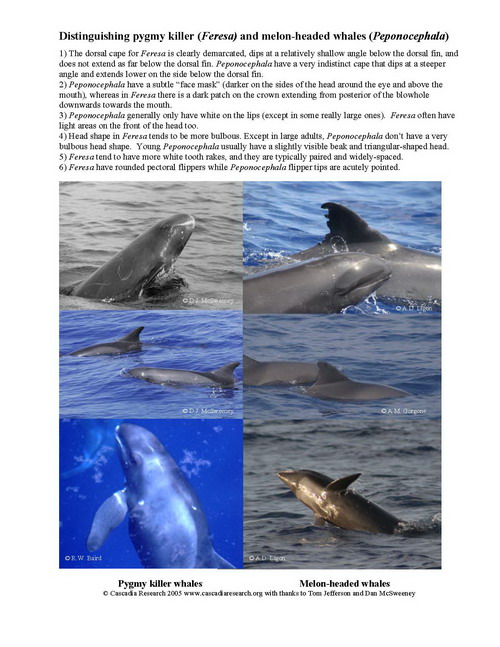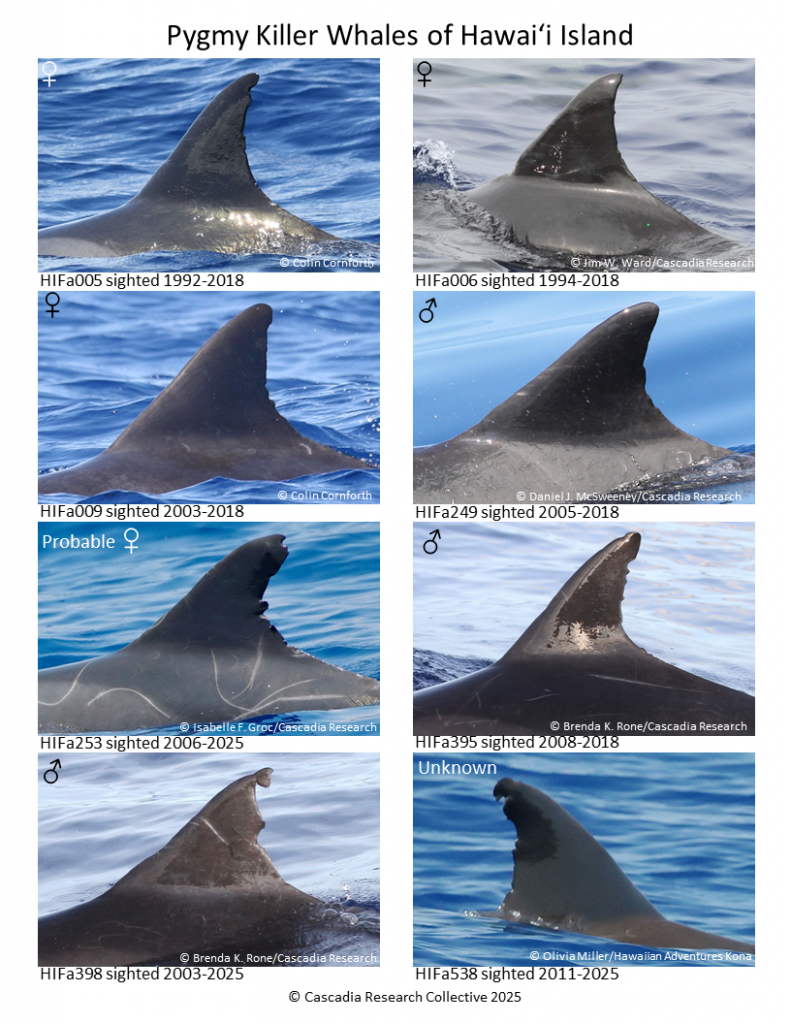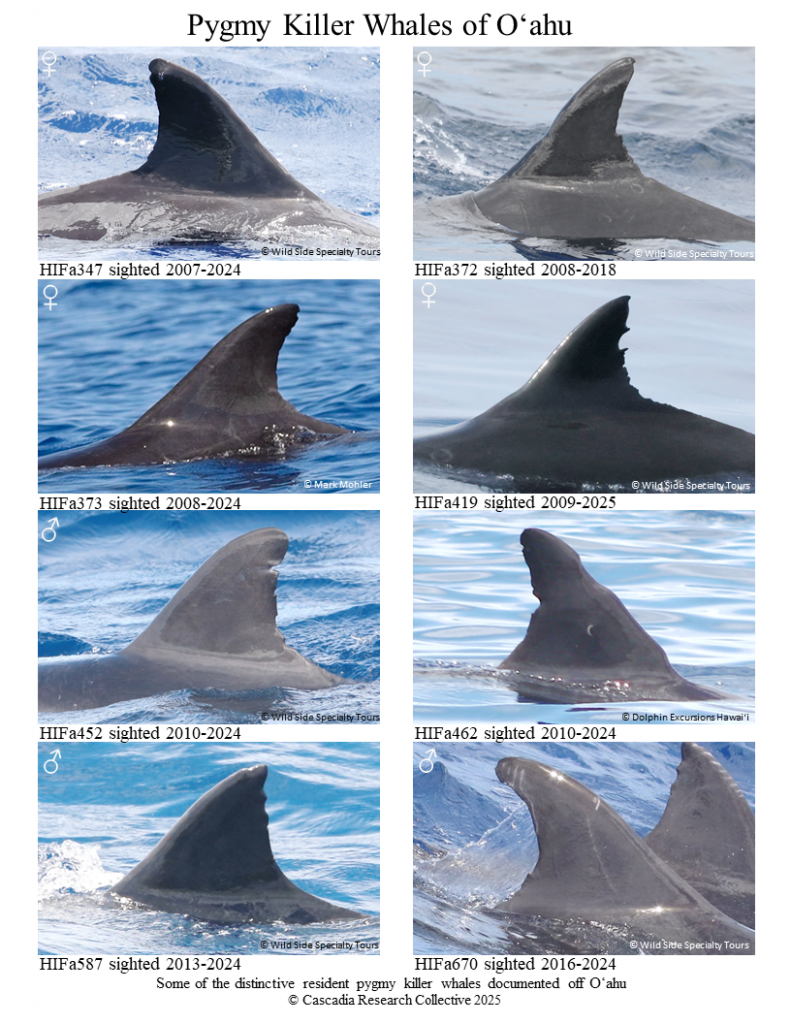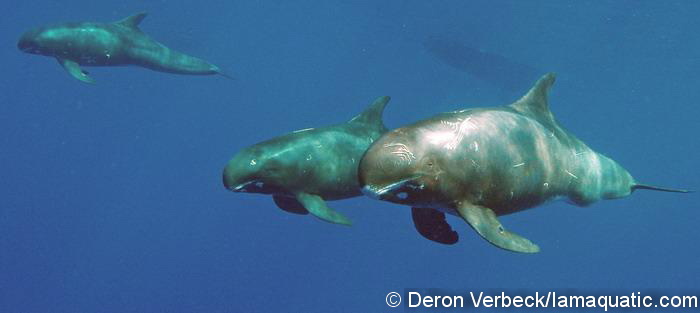
The pygmy killer whale, a small toothed whale found in tropical oceanic waters world-wide, is one of the least-frequently encountered species of delphinids (oceanic dolphins) in the world. More is known about pygmy killer whales in Hawai‘i than anywhere else in the world, based primarily on a long-term photo-identification study originally started by researcher Dan McSweeney of the Wild Whale Research Foundation, a non-profit group based on the island of Hawai‘i. Dan’s observations were combined with additional photo-identification effort since 2000 by Cascadia Research Collective, and results were published in Marine Mammal Science in 2009. This study has continued to date, based on our work and contributions of photos by many others, including tour operators and ocean users from Wai‘anae to Kona. Currently, we have data on pygmy killer whales from over 200 encounters and 6 satellite-tag deployments, with many photographs contributed by citizen scientists and other researchers, and we have over 400 distinctive individuals in our photo-ID catalog for this species! The most expansive sighting record we have is of an individual (HIFa373) seen 63 times between 2008 and 2020!
Pygmy killer whales are closely related to false killer whales, short-finned pilot whales and melon-headed whales, all of which are found in Hawaiian waters. They are most frequently confused with melon-headed whales.
A little bit of background on pygmy killer whales. Pygmy killer whales were first discovered based on two skulls, one described in 1827 and the other in 1874. The species was then effectively lost to science until 1952. The first six times live individuals were documented in the wild are worth reporting. The first live individual known to be of this species was harpooned, off Taiji, Japan, and brought in for processing. Although the individual was quickly flensed almost all the parts were obtained and the external appearance was recreated and described, along with the skeleton. The common name pygmy killer whale was first proposed based on this specimen by Yamada (1954). The second time this species was documented alive in the wild, off Senegal in 1958, the individual was captured and killed. The third known at-sea sighting was of a group of 14 individuals off Japan in 1963 – in this case the entire group was captured and taken into captivity, where all died within 22 days. The fourth recorded at-sea sighting of this species, also in 1963, ended a bit better, when only one individual in the group was captured and taken into captivity, this time in Hawai‘i. The fifth record of a live animal was an individual captured and accidentally killed in a tuna purse seine off Costa Rica in 1967. In the spring of 1969 a live individual was harpooned off St. Vincent. Finally, later in 1969, a group was observed in the Indian Ocean with none of them being killed or captured.
Although they are encountered only very infrequently, there is a small resident population of pygmy killer whales off the island of Hawai‘i and another one off O‘ahu and Penguin Bank. This is the first evidence of a resident population of this species anywhere in the world. Individuals have been re-sighted over periods of over 30 years (as of 2018), and they use the area year-round. In addition, using photographs of individuals traveling together in the same group, it is clear that some associations among individuals are very stable, similar to the long-term associations seen in some other species of whales such as false killer whales and short-finned pilot whales.
Because of the small population size the population is more at risk from human impacts than most species of whales and dolphins in Hawaiian waters. In a recent examination of pygmy killer whale mouthlines using underwater footage, we found that 62% of individuals have evidence of injuries stemming from anthropogenic sources, with 49% of these appearing to be consistent with fisheries interactions.A stranded pygmy killer whale found dead on O‘ahu in 2006 had evidence of interacting with fishing gear (a hook and line injury in the mouth), and Hawai‘i is also home to regular naval sonar exercises that potentially could impact this species. With the very low encounter rates it will be almost impossible to determine whether the population is increasing or decreasing or monitor the impacts of such activities as naval exercises. Also, the standard methods NMFS uses for monitoring population trends, large-vessel line-transect surveys, will not be feasible, given the low encounter rates.
We are continuing studies of this species in Hawai‘i. In early December 2008 the first-ever satellite tag was deployed on a pygmy killer whale off the island of Hawai‘i to examine movements, and another satellite tag was deployed on a pygmy killer whale in April 2009. Currently, we have data from 6 satellite tag deployments onto pygmy killer whales, including one deployment where dive data was recorded.
For copies of our publications on pygmy killer whales click here.
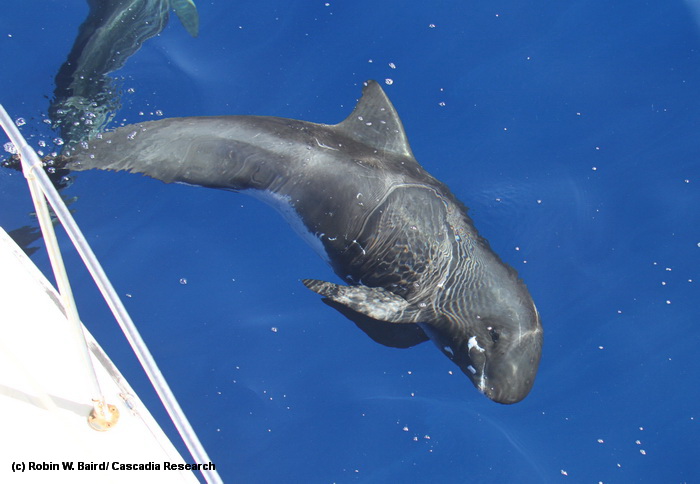
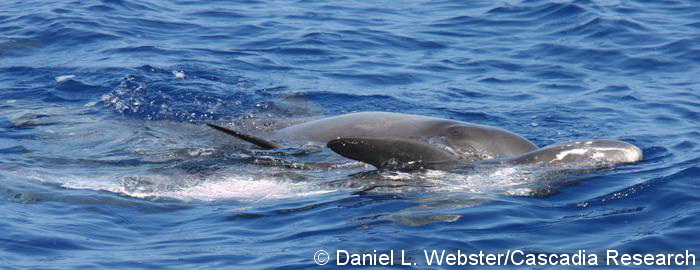
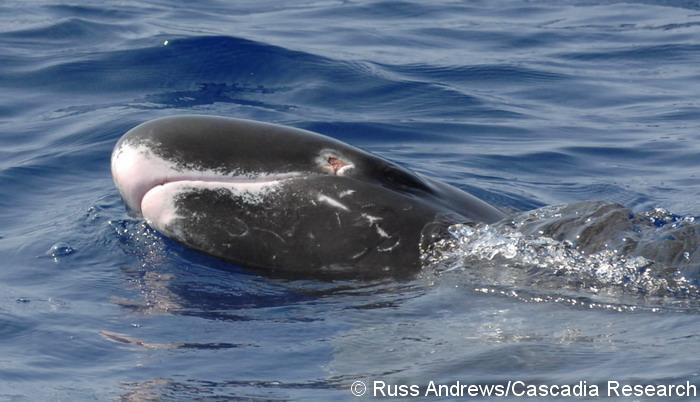
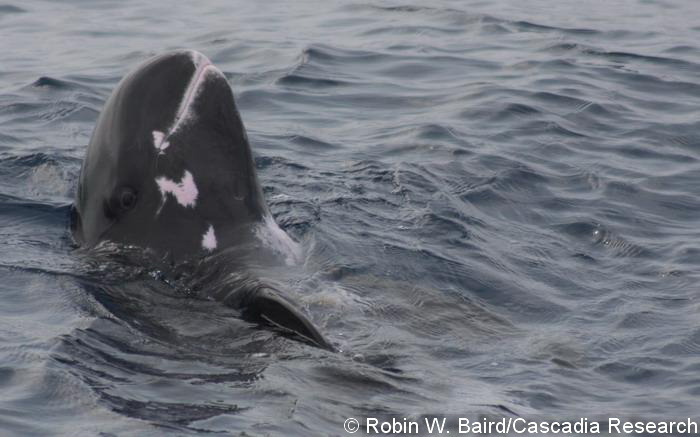
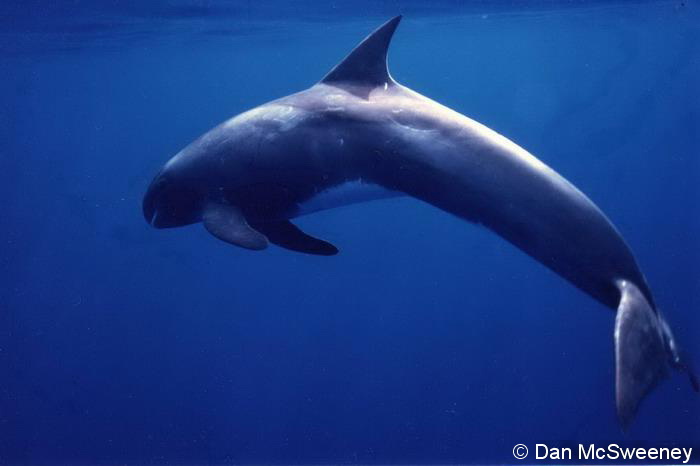
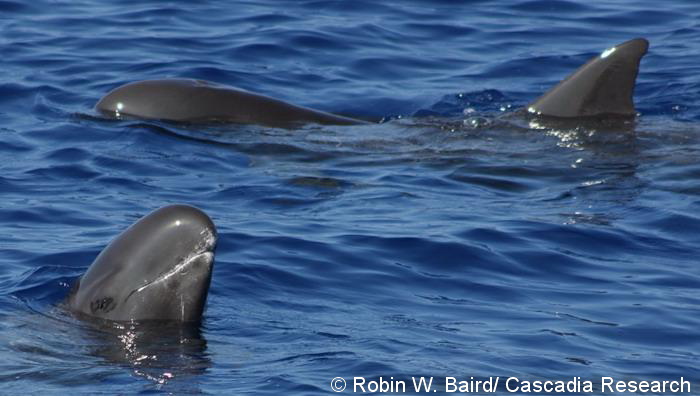
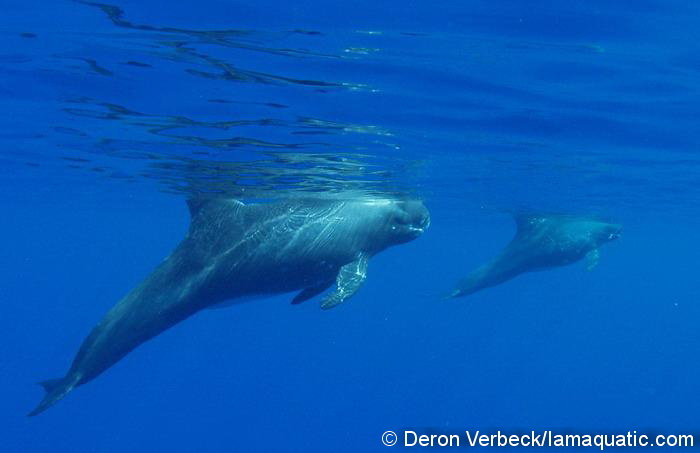
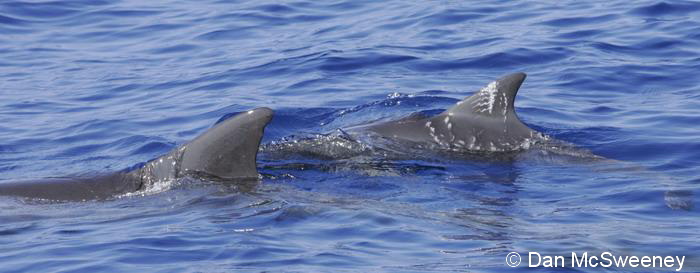
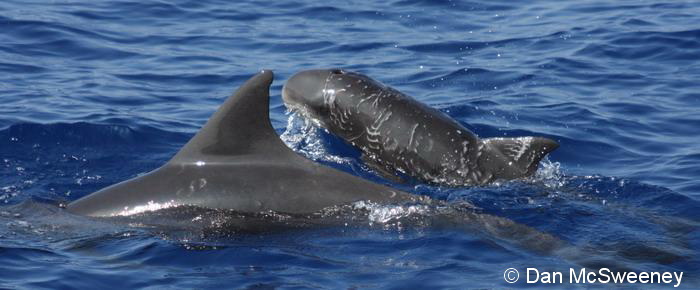
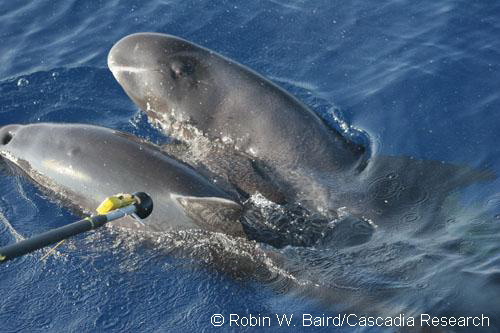
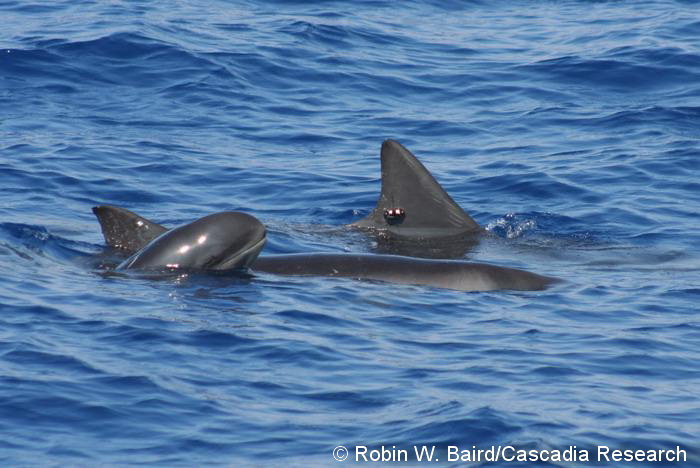
ID guides for ocean users
We’ve made some printable guides to distinguishing pygmy killer whales from melon-headed whales, along with some commonly seen IDs from O‘ahu and Hawai‘i for ocean users that you can download by clicking on the images below!
Videos of pygmy killer whales in Hawai'i
We occasionally collect video footage of pygmy killer whales as part of our field work in Hawai‘i – you can view some of our videos below!
Playlist
For more information on pygmy killer whales:
Society for Marine Mammalogy Fact Sheet on Pygmy Killer Whale
For more information on Pygmy Killer Whales, see the following publications and presentations:
- Baird, R.W. In press. Pygmy killer whale Feresa attenuata Gray, 1874. Chapter 17 in Ridgway and Harrison’s Handbook of Marine Mammals, Volume 2. Edited by T.A. Jefferson. Elsevier. Contact us for a pre-publication copy.
- Mahaffy, S.D., U. Gorter, and R.W. Baird. 2025. Neonatal facial pigmentation of pygmy killer whales (Feresa attenuata): a description from repeated observations of individuals in the wild. Aquatic Mammals 51(2): 138-143.
- Baird, R.W., S.D. Mahaffy, B. Hancock-Hanser, T. Cullins, K.L. West, M.A. Kratofil, D.M. Barrios, A.E. Harnish, and P.C. Johnson. 2024. Long-term strategies for studying rare species: results and lessons from a multi-species study of odontocetes around the main Hawaiian Islands. Pacific Conservation Biology 30, PC23027. https://doi.org/10.1071/PC23027. Download PDF copy. Download supplemental materials. Download satellite tag data.
- Ramos, E.A., K.L. Hartman, R.W. Baird, J.K. Lerma, F. Missael Rodríguez-González, and D.N. Orbach. 2023. Drone perspectives on cetacean mating and sex. Pages 225-249 in: Sex in Cetaceans. Edited by B. Würsig and D. N. Orbach. Springer. Download PDF copy
- Baird, R.W., C.J. Cornforth, S.M. Jarvis, N.A. DiMarzio, K. Dolan, E.E. Henderson, S.W. Martin, S.L. Watwood, S.D. Mahaffy, B.D. Guenther, J.K. Lerma, A.E. Harnish, and M.A. Kratofil. 2021. Odontocete Studies on the Pacific Missile Range Facility in February 2020: Satellite-Tagging, Photo-Identification, and Passive Acoustic Monitoring. Prepared for Commander, Pacific Fleet, under Contract No. N62470-15-D-8006 Task Order N6274219F0101 issued to HDR Inc., Honolulu, HI. Download PDF copy.
- Vanderzee, A., S.D. Mahaffy, D.S. Verbeck, P.C. Johnson, T. Cullins, and R.W. Baird. 2019. Keep an Eye on Me: Using Underwater Photos and Video from Citizen Science to Evaluate Prevalence of Injury in Pygmy Killer Whales in Hawai’i. Poster presented at the World Marine Mammal Conference, Barcelona, Spain, December 7-12, 2019. Download poster PDF.
- Yahn, S.N., R.W. Baird, S.D. Mahaffy and D.L. Webster. 2019. How to tell them apart? Discriminating tropical blackfish species using fin and body measurements from photographs taken at sea. Marine Mammal Science doi: 10.1111/mms.12584 Download PDF copy
- Baird, R.W. 2018. Pygmy Killer Whale. In Encyclopedia of Marine Mammals, 3rd Edition. Edited by Bernd Würsig, J.G.M. Thewissen, Kit Kovacs. Elsevier Inc. Download PDF copy
- Yahn, S.N, R.W. Baird, S.D. Mahaffy and D.L. Webster. 2017. How to tell them apart? Blackfish species discrimination using fin and body morphometrics obtainable from photos at sea. Abstract (Proceedings) 22nd Biennial on the Biology of Marine Mammals, Halifax, Nova Scotia, October 22-27, 2017. View abstract Download PDF copy
- Hancock-Hanser, B.L., R.W. Baird, K.M. Robertson, P.E. Rosel, A.A. Mignucci-Giannoni, and K.K. Martien. 2015. Examining the global phylogeography of a little known species: the pygmy killer whale (Feresa attenuata). Poster presented at the 21st Biennial Conference on the Biology of Marine Mammals, San Francisco, California, December 14-18, 2015. Download PDF copy.
- Beach, Kelly A., R.W. Baird, S.D. Mahaffy, D.L. Webster, D.J. McSweeney. 2015. Mouthline injuries as an indicator of fisheries interactions for false killer whales and pygmy killer whales in Hawai’i. Abstract (Proceedings) 21st Biennial Conference on the Biology of Marine Mammals, San Francisco, California, December 14-18, 2015. View abstract
- Foltz, K., R.W. Baid, G.M. Ylitalo and B.A. Jensen. 2014. Cytochrome P4501A1 expression in blubber biopsies of endangered false killer whales (Pseudorca crassidens) and nine other odontocete species from Hawai’i. Ecotoxicology doi: 10.1007/s10646-014-1300-0 Download PDF copy
- Baird, R.W., D.L. Webster, S.D. Mahaffy, G.S. Schorr, J.M. Aschettino and A.M. Gorgone. 2013. Movements and spatial use of odontocetes in the western main Hawaiian Islands: results of a three-year study off O’ahu and Kaua’i. Final report under Grant No. N00244-10-1-0048 from the Naval Postgraduate School. Download PDF copy
- Baird, R.W., D.L. Webster, J.M. Aschettino, G.S. Schorr and D.J. McSweeney. 2013. Odontocete cetaceans around the main Hawaiian Islands: habitat use and relative abundance from small-boat sighting surveys. Aquatic Mammals 39:253-269. Download PDF copy
- Baird, R.W., G.S. Schorr, D.L. Webster, D.J. McSweeney, M.B. Hanson and R.D. Andrews. 2011. Movements of two satellite-tagged pygmy killer whales (Feresa attenuata) off the island of Hawai‘i. Marine Mammal Science doi: 10.1111/j.1748-7692.2010.00458.x Download PDF copy
- Baird, R.W., G.S. Schorr, D.L. Webster, S.D. Mahaffy, J.M. Aschettino and T. Cullins. 2011. Movements and spatial use of satellite-tagged odontocetes in the western main Hawaiian Islands: results of field work undertaken off O‘ahu in October 2010 and Kaua‘i in February 2011. Annual progress report under Grant No. N00244-10-1-0048 from the Naval Postgraduate School. Download PDF copy
- Baird, R.W. 2010. Pygmy killer whales (Feresa attenuata) or false killer whales (Pseudorca crassidens)? Identification of a group of small cetaceans seen off Ecuador in 2003. Aquatic Mammals 36:326-327. DOI 10.1578/AM.36.3.2010. Download PDF copy
- McSweeney, D.J., R.W. Baird, S.D. Mahaffy, D.L. Webster, and G.S. Schorr. 2009. Site fidelity and association patterns of a rare species: pygmy killer whales (Feresa attenuata) in the main Hawaiian Islands. Marine Mammal Science 25:557-572. Download PDF copy
- Baird, R.W. 2006. Hawai’i’s other cetaceans. Whale and Dolphin Magazine 11:28-31. Download PDF copy
All photos are copyrighted and should not be used without permission.
Updated October 2025.
Return to the Hawaiian Dolphin and Whale Species Page
Got photos? We have photo-ID catalogs for several Hawaiian cetacean species! If you have photos that you would be willing to share, you can learn how to submit those to us at this link, or contact us at Hawaii@cascadiaresearch.orgRamos, E.A., K.L. Hartman, R.W. Baird, J.K. Lerma, F. Missael Rodríguez-González, and D.N. Orbach. 2023. Drone Perspectives on Cetacean Mating and Sex. Pages 225-249 in: Sex in Cetaceans. Edited by B. Würsig and D. N. Orbach. Springer.
